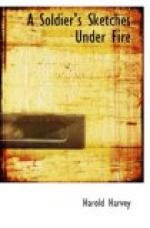The sketch of “Suicide Signal Box” takes us to a spot on the railway line close to the scene of one of the biggest battles of the war. Its chief feature is the dug-out actually under the line itself. Of course the line was not being used across the top of the dug-out. As a matter of fact, at this time a railway truck was run up to the edge nightly propelled by forty of our men, bringing filled sandbags for making a barricade across the line, thus affording the relieving party cover when getting out of trench. The position was known to us as “Suicide Signal Box,” because it was so dangerous as to be almost suicidal to cross the line, as was necessary to reach the road only five yards beyond. The ruined building is the signal box itself, protected by the line of sandbags in front of telegraph poles and shelled trees.
A most curious fact about this place was that, though it was being continually shelled by the enemy and their maxim guns were trained day and night on this very important position to catch troops coming up as relieving parties, it was a wonderful place in which to hear the birds sing. The larks trilled at every dawn to herald the coming day, and never seemed in the least disturbed by the roar of artillery. In the left-hand corner of the sketch will be noticed the firing platform, over which is the “funk hole,” so called from its being the refuge to run to when the shells arrive. The soldier buries his head like the ostrich—only he beats the ostrich by getting his shoulders in as well—and then feels fairly secure.
A MILE-AND-A-HALF OF HELL.
[Illustration: A ghastly promenade.]
I show a little bit of a ghastly promenade near Messines, some six miles from Armentieres. The road of which the bit in the foreground leads to what remains of a very handsome gateway to a park is a mile-and-a-half in length, and had to be traversed by our men in order to get to the British position, which was placed beyond the left corner of the picture (where the broken tree slants). Relieving parties had to cover the whole of this distance exposed to the enemy’s enfilading fire from two sides of the triangle right up to the apex. The apex was a British trench in the most advanced position we could possibly hold. Our determination to throw back the enemy made it absolutely necessary to hold it. The road was covered by the Germans’ maxim guns from three points, both down each side and from the centre between the pillars of the gateway. Our method of advance was in Indian file at several paces apart, and instructions were given that whenever the maxims fired upon us we were to drop flat on the ground immediately, and when the searchlight was turned upon us (which it frequently was with blinding force) we were to stand stock still in whatever position we were, the reason being that even with such powerful searchlights as are used by the enemy, which have a perfect range of five miles, it is easier for them to distinguish a moving object than a stationary one. It was almost unendurable to have our rifles in our hands—the barrels frequently hit by the enemy’s bullets—and to have to stand still unable to use them—by order; but of course it would have been fatal to have opened fire. We should all have been annihilated.




